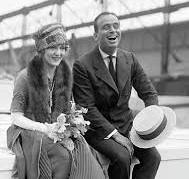The Roaring 20s Fashion: A Look Back at the Glamorous Decade
The 1920s, also known as the “Roaring Twenties,” was a decade of significant social and cultural change, and this transformation was reflected in the fashion of the time. The post-World War I era brought about a newfound sense of liberation and freedom, which was vividly expressed through the clothing styles of the period.
One of the most iconic elements of 1920s fashion was the rise of flapper style. Flappers were young women who rebelled against traditional norms by embracing a more relaxed and daring fashion sense. They wore knee-length dresses with dropped waists, loose silhouettes, and intricate beading or fringe details. The flapper look symbolised a break from the restrictive Victorian clothing styles and represented a more modern and independent woman.
Another key feature of 1920s fashion was men’s suiting. Men’s fashion in the 1920s saw a shift towards more casual yet elegant attire. Three-piece suits with wide-legged trousers and structured jackets became popular among men during this period. The influence of Hollywood stars like Charlie Chaplin and Rudolph Valentino further popularised this sophisticated yet comfortable style.
Accessories played a crucial role in completing an outfit in the 1920s. Women adorned themselves with cloche hats, long strands of pearls, feathered headbands, and stylish handbags. Men accessorised their suits with fedora hats, pocket squares, cufflinks, and stylish leather shoes.
The fabrics used in 1920s fashion were luxurious and often featured intricate embellishments such as sequins, beads, and embroidery. Silk, satin, velvet, and chiffon were commonly used to create elegant evening gowns for women while wool and tweed were popular choices for men’s suits.
In conclusion, the fashion of the Roaring Twenties encapsulated a spirit of rebellion, freedom, and glamour that continues to inspire designers and fashion enthusiasts today. The bold styles embraced during this era marked a significant departure from traditional norms and paved the way for modern fashion as we know it.
Celebrating the Roaring 20s: Liberation, Flapper Style, and Fashion Elegance
- 1. Embraced liberation
- 2. Iconic flapper style
- 3. Elegance and sophistication
- 4. Accessorising creativity
- 5. Luxurious fabrics and embellishments
Challenges of Roaring ’20s Fashion: Inclusivity, Comfort, and Accessibility
1. Embraced liberation
The fashion of the Roaring 20s embraced liberation by symbolising a departure from traditional norms, enabling individuals to express themselves more freely. During this vibrant era, clothing styles became a form of rebellion against societal constraints, empowering people to embrace a more daring and individualistic approach to fashion. The shift towards relaxed silhouettes, bold patterns, and innovative designs reflected a newfound sense of freedom and self-expression that defined the spirit of the 1920s.
2. Iconic flapper style
The iconic flapper style of the Roaring Twenties marked a significant shift in fashion, introducing daring and innovative clothing styles that have left a lasting impact on modern trends. The flapper look, characterized by its knee-length dresses with dropped waists, loose silhouettes, and intricate beading or fringe details, symbolized a break from traditional norms and represented a more liberated and independent woman. This bold and revolutionary style continues to inspire designers and fashion enthusiasts today, showcasing the timeless appeal and influence of 1920s fashion on contemporary trends.
3. Elegance and sophistication
During the Roaring Twenties, one notable pro of the fashion era was the elegance and sophistication embodied in men’s suiting. Characterised by wide-legged trousers and structured jackets, the suiting of the 1920s exuded a perfect blend of casual comfort and refined style. This combination of elements not only provided men with a sense of sartorial confidence but also showcased a timeless aesthetic that continues to influence modern menswear trends. The emphasis on tailored fits and attention to detail in men’s fashion during this period exemplified a sophisticated approach to dressing that remains iconic to this day.
4. Accessorising creativity
One notable advantage of 1920s fashion was the opportunity for accessorising creativity. The focus on accessories such as cloche hats, pearls, and fedora hats provided individuals with a platform for personal expression and allowed them to inject unique flair into their outfits. By carefully selecting and combining different accessories, people could showcase their individuality and style preferences, making each ensemble truly distinctive and memorable. This emphasis on accessorising not only enhanced the overall look but also encouraged creativity and self-expression in fashion during the Roaring Twenties.
5. Luxurious fabrics and embellishments
The incorporation of luxurious fabrics such as silk and satin, along with intricate embellishments like sequins, beads, and embroidery, was a standout feature of 1920s fashion. These elements elevated the glamour of the era’s clothing, resulting in the creation of exquisite garments that exuded opulence and sophistication. The meticulous attention to detail in the choice of fabrics and embellishments added a touch of extravagance to the fashion of the Roaring Twenties, reflecting the spirit of prosperity and celebration that defined the decade.
1. Limited Body Inclusivity
One notable con of 1920s fashion was its limited body inclusivity. The prevailing slim and boyish silhouette of the era, epitomised by the ‘flapper’ style, may not have been flattering for all body types. This narrow definition of beauty excluded individuals who did not conform to the idealised figure, thereby marginalising those with different body shapes and sizes. The emphasis on a specific standard of beauty in 1920s fashion underscored a lack of diversity and inclusivity that failed to celebrate the full spectrum of human forms and expressions.
2. Lack of Comfort
During the Roaring 20s, one notable drawback of the fashion trends was the lack of comfort experienced by women due to the emphasis on tight-fitting garments and restrictive corsets. The pursuit of a slim, boyish silhouette often meant sacrificing comfort for style. Women found themselves constrained by these constricting clothing choices, which hindered their ease of movement and overall comfort. The physical discomfort caused by these fashion norms highlighted a significant downside to the glamorous aesthetic of the era, showcasing that style sometimes came at the expense of practicality and well-being.
3. Accessibility Issues
During the Roaring 20s, one significant con of the fashion trends was the issue of accessibility. The opulent fabrics and elaborate embellishments that defined 1920s fashion made these garments exorbitantly expensive, rendering them out of reach for individuals with limited financial resources. This exclusivity in pricing created a stark division in fashion accessibility, where only the affluent could afford to indulge in the luxurious styles of the era, further accentuating social and economic disparities within society.

